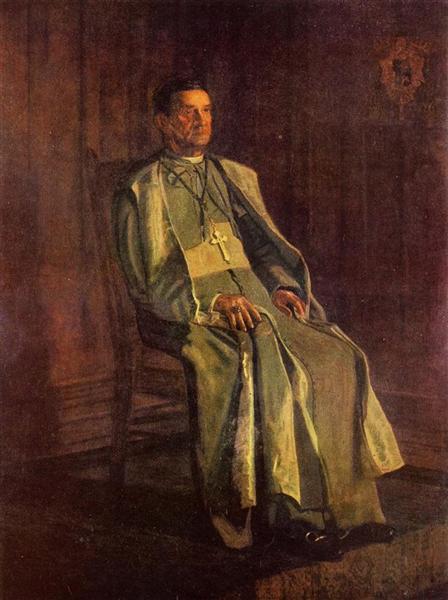Opis
The work "Monsignor Diomede Falconia," painted in 1905 by noted American artist Thomas Eakins, encapsulates not only Eakins' technical prowess, but also a deep understanding of the human figure and psychological portraiture. In this painting, Eakins presents a churchman who exudes dignity and serenity, presenting not only the physical appearance of the subject, but a performance that suggests a complexity of character.
The use of light in the work is particularly notable. Eakins employs a subtle chiaroscuro that highlights Monsignor Falconia’s features, accentuating the texture of his skin and clothing. Warm tones predominate in the palette, blending well with the earthy tone of the monsignor’s skin and the dark fabric of his cassock. The choice of colors is not fortuitous; they reinforce the solemnity and authority of the subject, while strategically placed shadows add a sense of three-dimensionality that invites the viewer to consider the sitter’s inner world.
Falconia's figure is the centre of attention, standing out against a neutral background that does not distract but rather complements the visualisation of her person. The composition is balanced: the monsignor, with his serene countenance, is positioned in a posture that suggests both welcome and firmness. His direct gaze invites reflection and dialogue, while his carefully positioned hands provide a sense of authority and receptivity.
A master of realism, Eakins was dedicated to capturing the essence of his subjects directly and without unnecessary embellishment. His work is characterized by a scientific approach to the human body, as well as an almost obsessive attention to detail. This work is a testament to his penchant for making portraits that transcend the superficial, offering the viewer a genuine glimpse into the soul of the subject. This is reflected in the way every fold of the Monsignor’s clothing and every wrinkle on his face is articulated with incredible precision, illustrating the passage of time and the wisdom of a life lived authentically.
Eakins was also interested in anatomy and physiology, an interest that is evident in his ability to portray not only visible bone and muscle structure, but also the subtlety of facial expressions. Falconia's gaze, both penetrating and kind, reflects a deep understanding of the human condition, a recurring theme in Eakins' work, which often explored the intersection of art and science.
In the context of the work, it is interesting to note that Eakins produced several portraits throughout his career, all characterized by that same search for truth in representation. Although less well-known than his more iconic works, such as "The Gross Clinic," "Monsignor Diomede Falconia" stands firmly as a significant piece, on a par with his explorations into the intimacy and psychology of the human figure.
This painting not only frames an individual in a specific moment, but also enters into conversation with Eakins’ legacy as a pioneer in modern portraiture. In short, “Monsignor Diomede Falconia” reveals the virtues of a master who, through technique and introspection, manages to establish a deeply human bond with the viewer, reminding us of art’s ability to illuminate the essence of our shared experiences.
KUADROS ©, a famous painting on your wall.
Hand-made oil painting reproductions, with the quality of professional artists and the distinctive seal of KUADROS ©.
Painting reproduction service with satisfaction guarantee. If you are not completely satisfied with the replica of your painting, we will refund 100% of your money.

